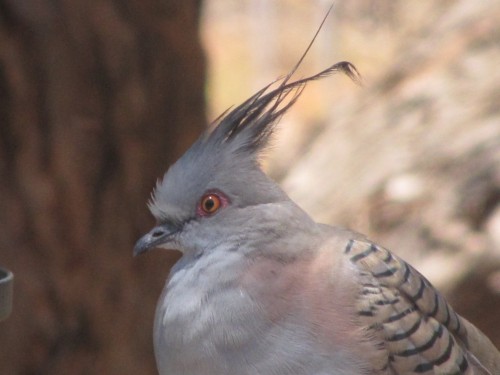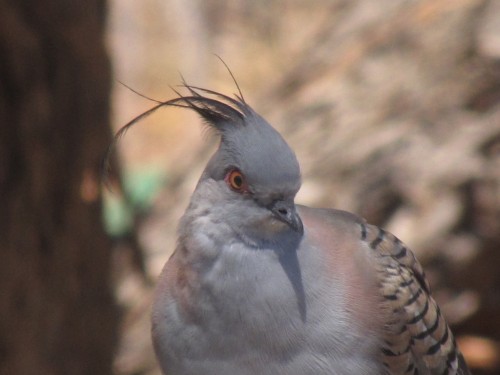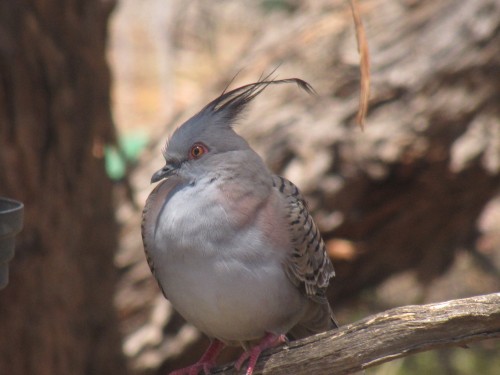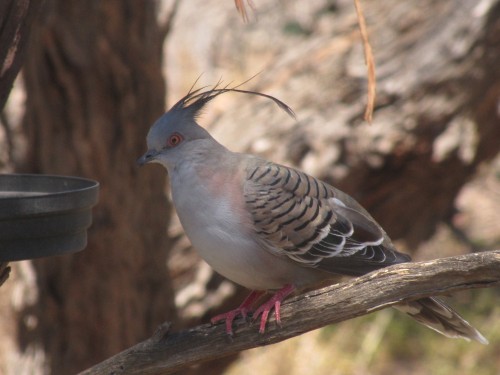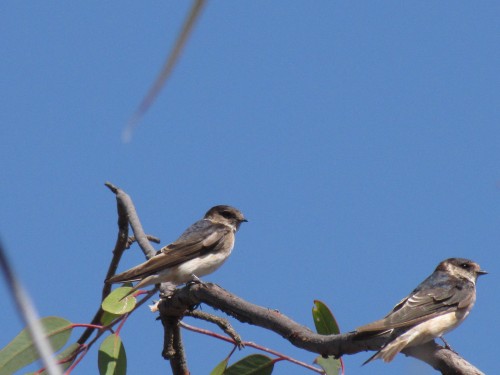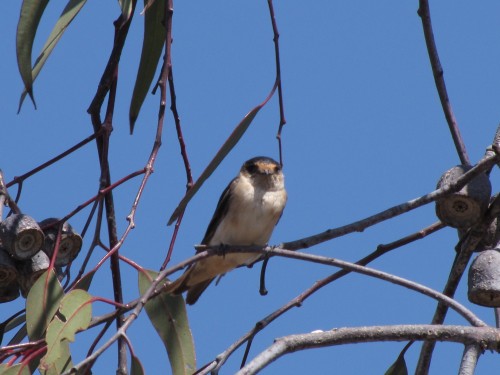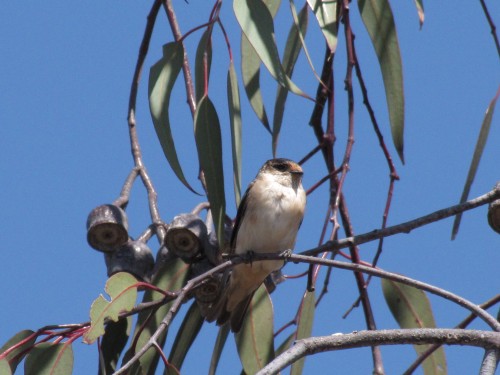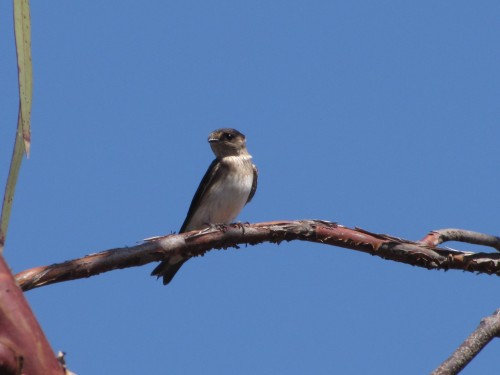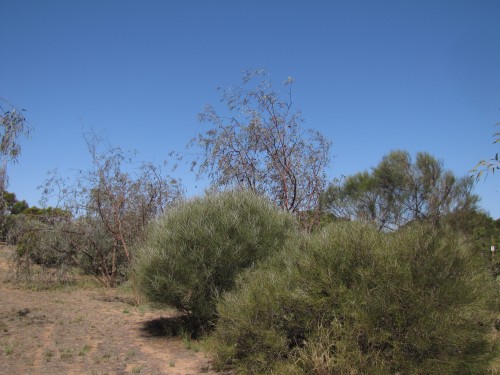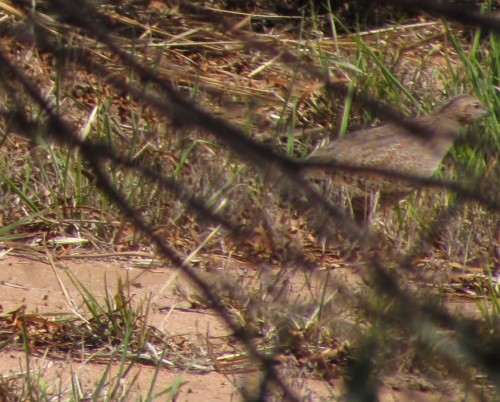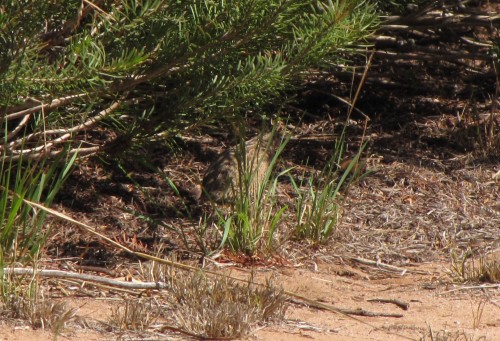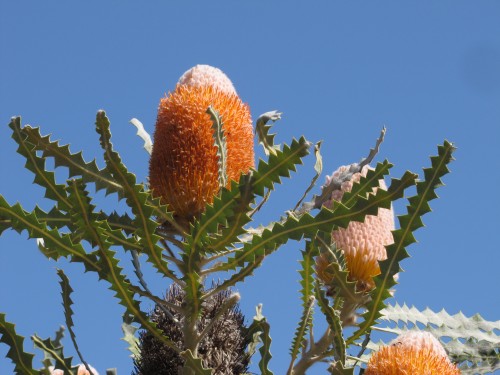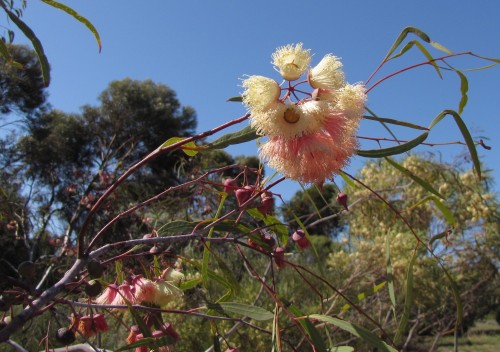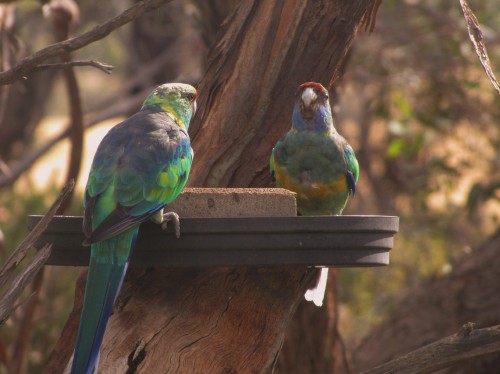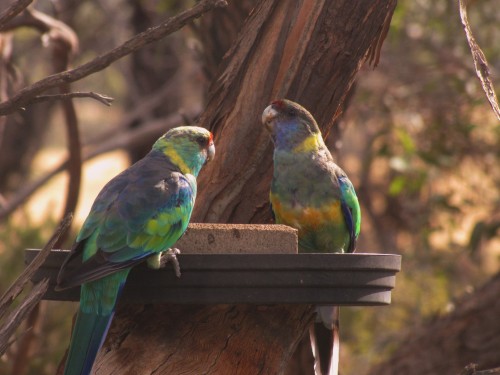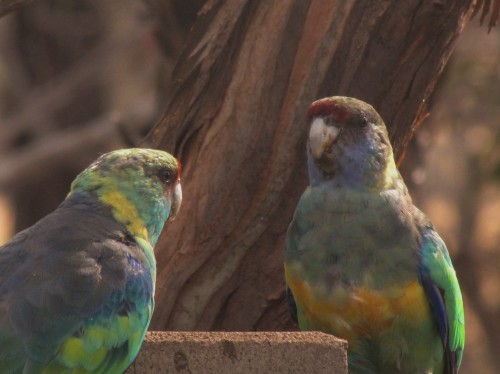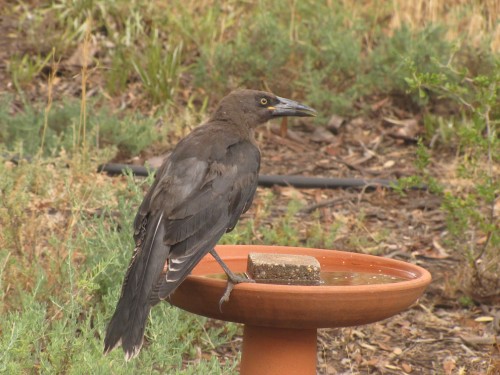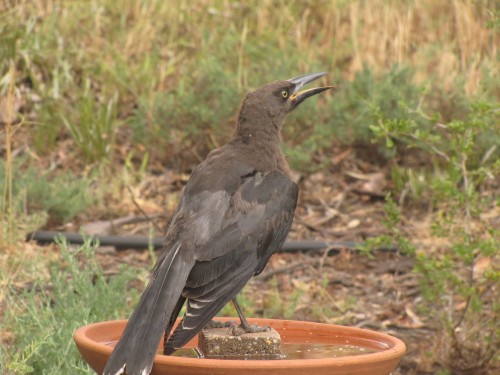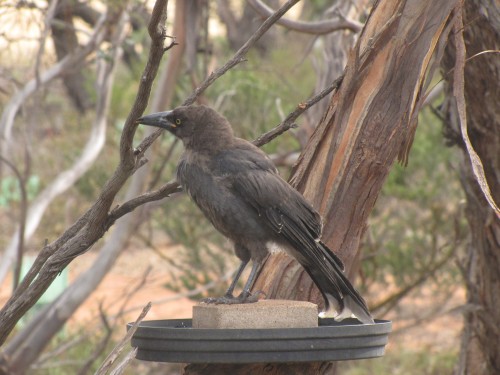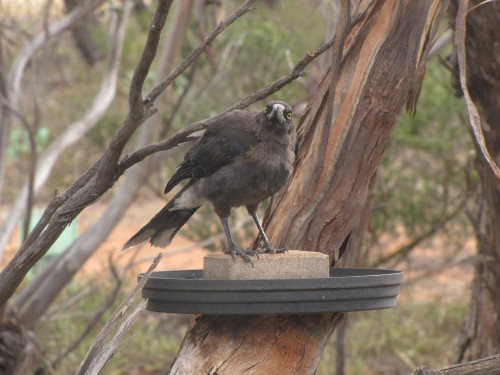Topsy the Crested Pigeon
Over recent weeks my wife and I have been intrigued by one of our resident Crested Pigeons – shown in the photos on today’s post. We suspect that she is a female because another pigeon was displaying to her recently. We have given her the name “Topsy” because she has some extra-long feathers making up her crest. I am not sure what has caused this slight aberration, but it certainly makes her stand out from the other pigeons in our garden.
Like all of the Crested Pigeons and Spotted Turtledoves resident in our garden and on our five-acre block, “Topsy” comes frequently to our bird baths for a drink. Today, while I was having a cuppa after lunch she came once again. She spent a few minutes on a nearby branch preening before flying down for a drink. She then flew down to the ground and sat down in the sunshine. She immediately lifted up one wing and held it with the underparts exposed to the warm sun. “Topsy” then stood up, changed position and raised the other wing in the same manner.
While I haven’t seen this sunbathing behaviour in many species I have observed it in Spotted Turtledoves, Red wattlebirds, Noisy Miners and Australian Magpies. It is surprising that there is very little mention of this behaviour in the literature, but this article on the Australian Birdlife site gives the topic a good coverage. The article suggests that this sunbathing behaviour could be aimed at ridding the birds of unwanted lice.
Further reading:
- Sunny side up – the article I referred to above
- An Australian Magpie sunning itself – this is an old post written some years ago. It shows a series of 10 photos of a magpie sunning itself.
Tree Martins all a twitter
A few weeks ago we had a day out with friends of ours. It was my wife’s birthday and after a wonderful lunch in one of the local hotels, we drove from Murray Bridge down south to Wellington. We had a twenty-minute wait to cross the River Murray on the local ferry; for some reason, we struck a very busy time. Driving off the ferry and heading east towards Tailem Bend for about a kilometre we turned off to the left. Several hundred metres on we came to the Pangarinda Botanic Gardens, one of our favourite places to visit near where we live.
These gardens, formerly known as an arboretum, are extensive plantings over 12 hectares of Australian native plants. This is always of particular interest to my wife – you can visit her site Mallee Native Plant Nursery here. While our visit coincided with the latter part of a very hot and dry summer, there was still a good variety of plants flowering. Late winter and early spring are certainly the best times to visit.
I have also found that wherever one finds extensive stands of Australian plants, there is also a good chance of a pleasing variety of birds. We found a newly installed picnic table to enjoy an afternoon cuppa and some birthday cake. While we sat there enjoying the bright, sunny day and gentle breeze, I was able to make a good list of birds seen and heard.
One of the bird species I quickly saw was the Tree Martin. A loose flock of about 50 or 60 martins were swooping and soaring overhead and over one particular group of eucalyptus trees about 50 metres away. After enjoying our cuppa my friend Keith and I wandered over to get a closer look. We could see that many of the martins were perching on several trees. Now I immediately thought that this was a good opportunity to get some close-up photos of this species. Usually, I only get to see this species on the wing, usually high overhead, not a good way of getting photos of this small species. They also fly very quickly.
I was able to approach to within about 10 metres of the tree and I managed to take a series of lovely photos as shown in today’s post (see above and below). While I have seen individuals and even a small group landing near to each other in a tree or on electricity wires, this is the first time I have seen such large numbers all settling near to one another. I am not sure why they were doing this. Then after a minute or so they would all take off again for a minute or two, before settling in the trees again. Perhaps they were just letting their food settle; there were plenty of insects on the wing that day so it was a feast for them, I guess.
Further reading:
Calling up a Brown Quail
Yesterday was my wife’s birthday.
To celebrate we went out to lunch with friends, and then drove south to Wellington on the River Murray. After crossing the river on the ferry we drove the short distance to the Pangarinda Botanic Gardens (formerly known as the Pangarinda Arboretum). My wife enjoys exploring places where native Australian plants are the feature. You can check out her site about Australian plants here.
We found a shady spot in the middle of the gardens, complete with a table and seats. The garden all around us was alive with birds, especially dozens of New Holland Honeyeaters. We also saw White-browed Babblers, Red Wattlebirds and Little Wattlebirds, along with dozens of Tree Martins soaring on the breeze hawking for insects (photos to come in a few days’ time).
As we were having a cuppa and some delicious birthday cake, we heard an interesting call nearby. It wasn’t long before we spotted a quail-like bird skulking through the garden about 50 metres away. I checked my bird app on my phone and immediately recognised the call of the Brown Quail. I knew that I didn’t have a photo of this species, so I set off in pursuit. I actually managed only two photos which I have cropped and shown here today. They are not brilliant photos, but they are the best I have.
This is the first time I have seen this species, even though they are relatively widespread in the region where I live. They can be quite shy birds, hiding in grasses and bushy areas. I guess that they have found these gardens to their liking and are getting used to people being around quite often. I was amused when my friend Keith started imitating the call – and both birds answered him from nearby. They also answered the call from the app on my phone. Neither Keith’s call, nor that from my phone made them come closer to investigate. At one point one of them did fly low over the table where we were sitting, but it went straight into a bushy area and out of sight.
As far as I can tell from my memory and records, this sighting is a “lifer“, that is, it is the first time in my life I have seen this species.
Further reading (click on the title):
- Mallee Native Plants – my wife’s site about Australian plants
- Pangarinda Arboretum – some flower photos are featured in this post
- Birds and plants of Pangarinda Arboretum – more photos of the beautiful plants in these gardens
- Spotted Nightjar at Pangarinda
- Red-capped Robin at Pangarinda – featuring possibly my favourite photos of any bird
Below I have included several flower photos taken yesterday.
Mallee Ringnecks on a hot day
During the hot weather we have experienced so far this summer here in South Australia I have had many opportunities to take photos of the constant parade of birds visiting our bird baths. We have positioned the water containers where we can see the birds from our sun room, a room we use often so we can enjoy the birds in our garden.
The Mallee Ringnecks shown in today’s set of photos are resident birds in our garden. This means that we see them every day. On several occasions in recent times they have raised a brood of young ones. We love seeing their colourful feathers as they fly around the garden and especially when they come to drink and bathe. At those times we can really get to appreciate their colours up close.
On the other hand, we have a love-hate relationship with these birds. We hate it when they get into our fruit trees, nibbling at the almost ripened fruit before we have a chance to rescue the fruits of our labours. This year, because of a bad back, I have not been able to cover the trees with netting. Consequently the birds – and possibly the resident possums as well – have taken some of our fruit. We were especially looking forward to a large crop of nectarines. (Those we were able to rescue were delicious.) I must get to the pears before the birds get to them as well.
Further reading:
- Ringnecks and kites
- Mallee Ringnecks nesting
- A small birding accident
- The beautiful Eastern Rosella parrot
Hot weather birding
Over recent posts I have written about the very hot conditions we have had here in South Australia this summer. I won’t bore you by stating the obvious yet again. When the weather gets much over 30C (86F) I tend not to go out birding, though I have on occasions been out in much hotter weather.
When the temperature soars here in Murray Bridge (80 km SE of Adelaide) I tend to stay indoors as much as possible. It is one of the joys of being ‘retired’. On these occasions we have the delight of a constant stream of birds coming to our bird baths. These containers are strategically placed in our garden where we can observe – and photograph – the birds at our leisure. On very hot days like we have had over recent months the stream has sometimes been a flood.
When the Grey Currawongs come to drink, most of the smaller birds keep their distance. I am not surprised by this; the Currawong’s bill and head is about the size of birds like the thornbills or the wrens. I guess that the smaller species know instinctively that the Currawong is capable of raiding their nests for eggs and baby birds, and so they remain at a respectful distance while the bigger birds are drinking.
During one of our recent hot spells this juvenile Grey Currawong came for a drink. I can tell that it is a young one not long out of the nest because of the downy feathers, as well as the yellow gap on the bill. Only a few days before these photos were taken I saw the juveniles being fed by the adults.
Once the Currawong had finished drinking, the smaller birds quickly returned.
